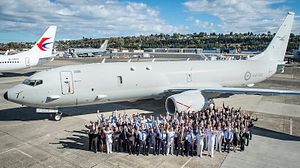The first Boeing P-8A Poseidon maritime surveillance aircraft for the Royal Australian Air Force (RAAF) has been officially rolled out on September 27, according to a Boeing press release. The rollout ceremony took place at the company’s airfield in Seattle and was attended by a host of dignitaries including the head of the RAAF, Air Marshall Leo Davies.
“It is a privilege to accept the first Australian P-8A Poseidon aircraft,” Davies said at the rollout ceremony. “The P-8A is the latest in a pedigree of Boeing aircraft that have provided important and significant operational capability to Australia.”
The first P-8A will arrive in Australia on November 15 flown by a RAAF crew. RAAF aircrew and maintenance personnel have been undergoing training on the P-8A aircraft in the United States since early 2015. “Speaking to my team today, it is obvious they have been the recipients of some of the best training in the world from the US Navy,” Davies said.
The RAAF is slated to receive 15 P-8A Poseidon aircraft in two tranches by the late 2020s. The expected completion date for the four aircraft is June 2017. “Initial operating capability (IOC) for the eight aircraft of the first tranche is scheduled for the period 2017-2020, with full operating capability by 2021,” I reported elsewhere. I Total cost for the first eight P-8A Poseidon is A$4 billion ($3.6 billion), including the cost of support facilities.
Over the next three years, the RAAF will slowly phase out its fleet of 15 Lockheed AP-3C Orion maritime patrol aircraft. As I reported elsewhere (See: “Australia’s First New Anti-Submarine Warfare Plane Completes Maiden Flight”):
The P-8A Poseidon is a military variant of Boeing’s Next-Generation 737-800 commercial airplane equipped with advanced anti-submarine, anti-surface warfare and intelligence, surveillance, and reconnaissance capabilities. (…)
The aircraft has an internal fuel capacity of 34 tons providing it with a maximum range of 7,242 kilometers (4,500 miles) without refueling.
Furthermore, the P-8A sub-hunting plane is capable of remaining “on station conducting low level Anti Submarine Warfare (ASW) missions for over four hours at a range of more than 1,200 nautical miles (2,200 km) from base,” according to the RAAF website. “The P-8A has 11 weapon hard points (five in the bomb bay, four under the wings and two under the fuselage) and can carry over 22,000 pounds (10,000kg) of weapons.”
The RAAF’s new sub-hunting planes are part of a larger modernization effort by the Australian military in the years ahead. Australia’s defense budget will increase by over 80 percent over the next decade. “Under this new budget model, defense spending is slated to grow to A$42.4 (US$30.42) billion by 2020-21, reaching two percent of Australia’s GDP based on current projections. Overall spending in the next ten years for ‘investment in new and enhanced capabilities’ will add up to A$195 (US$140) billion,” I explained in February.
































